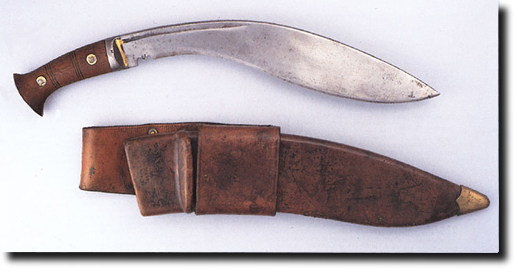
There are many stories of the Gurkhas, their stealth and lack of fear which involve the Khukri. During World War 2, Rifleman Thaman Gurung used to go off alone at night stalking Germans and quietly beheading them with his Khukri. The effect on German morale was devastating. Many VCs were won by Gorkhas over the years, most of them involved the deadly use of the khukri.
The famous khukri carried by Gurkha soldiers is a a side-arm that complements the main fire-arm. The main fire-arm carried by the Indian Army is the INSAS. As a weapon the Khukri has been used with deadly effect. The cutting action is an upward diagonal swipe with the neck being the main target. The blade is thick on the outside edge making the wide part heavy like an axe. The khukri is never
thrown. It is said that a Gurkha does not unsheathe the knife without drawing blood.
It is generally 16 or 17 inches long, the blade being 12 to 13 inches. The haft is made of wood, buffalo horn, bone or ivory and The khukri carried by modern day Gurkhas (post World War 2) is smaller, being more a traditional part of the uniform and a deadly weapon. There are two small ‘mini-khukris’ in the sheath; one is for sharpening the blade the other is for skinning.


